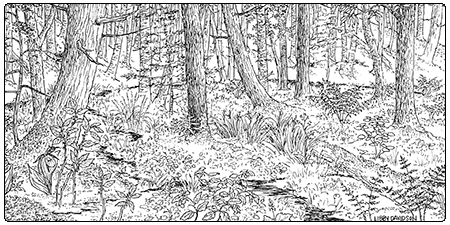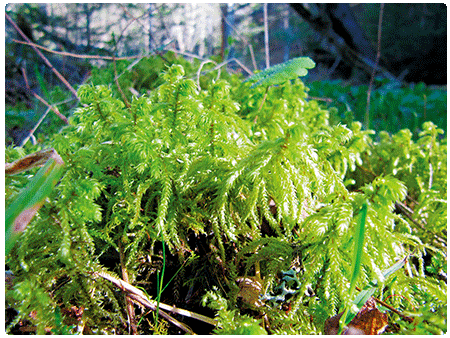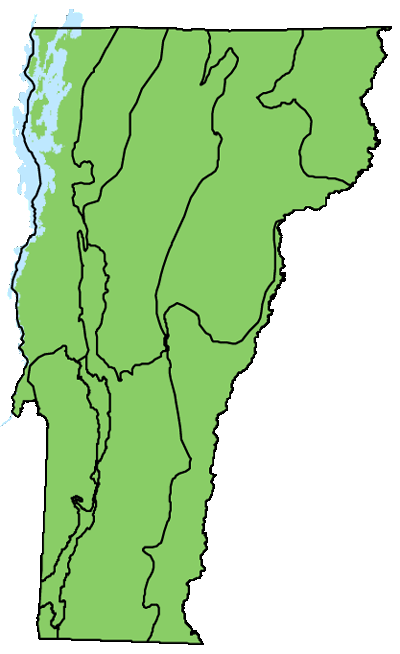Ecology and Physical Setting
Cool, shady, and rich in species, Hemlock-Balsam Fir-Black Ash Seepage Swamps may be small, but they are botanical hot-spots. Most swamps are smaller than 20 acres and many are less than three acres in size.
Hemlock-Balsam Fir-Black Ash Seepage Swamps are widely distributed in Vermont, but they are most common at elevations below 2,000 feet. They occur in small basins or on gentle slopes. A key feature of these swamps is that they receive groundwater discharge from seeps or springs that provide mineral enrichment and support many species of calcium-loving plants. It is common to find seepage waters at the swamp margins. Because of this constant source of groundwater, Hemlock-Balsam Fir-Black Ash Seepage Swamps typically form the headwaters of perennial streams. There is considerable variability in soils in these seepage swamps, with organic soil depth ranging from just a few inches to over 16 feet.
Hemlock-Balsam Fir-Black Ash Seepage Swamps usually occur as isolated wetlands surrounded by upland forest, but they may also occur with other seepage wetlands.
Vegetation

Hemlock-Balsam Fir-Black Ash Seepage Swamps are rich in vascular plant and bryophyte species, with up to 85 species recorded in some swamps. Typically, hemlock and balsam fir are co-dominants in the relatively closed canopy layer. However, swamps with only hemlock occur in warmer regions, whereas swamps with only balsam fir occur in cooler regions. Black ash is a characteristic species of seepage swamps and it may approach co-dominance with hemlock and fir. Other canopy species include yellow birch, red maple, red spruce, and white pine.
The shrub layers are generally sparse. Winterberry holly and Canada honeysuckle are typically present in low abundance. In cooler settings, mountain holly and velvetleaf blueberry may be present. In warmer areas, one may find spicebush, highbush blueberry, and poison sumac. Many swamps have shrubs indicative of the mineral-enriched waters. These shrubs include alder-leaved buckthorn, red-osier dogwood, poison ivy, and poison sumac.
The herb layer is diverse. Cinnamon fern is often dominant, but it is the abundance of seepage indicator species that defines these swamps. These include water avens, bristle-stalked sedge, inland sedge, golden saxifrage, swamp saxifrage, foamflower, spotted touch-me-not, sensitive fern, dwarf raspberry, and slender mannagrass. Rare and uncommon species indicative of groundwater seepage include small yellow lady’s slipper, large yellow lady’s slipper, showy lady’s slipper, and sweet coltsfoot. Hummocks may be high enough to create a more acidic environment with minimal groundwater influence, and here, boreal herbs including starflower, Canada mayflower, bluebead lily, and goldthread are common.
Bryophyte cover is high in most swamps. Common fern moss is one of the most characteristic mosses. Bryophytes indicative of groundwater seepage include shaggy moss, Calliergon cordifolium, Sphagnum squarrosum, Sphagnum teres, Sphagnum warnstorfii, and the liverwort Trichocolea tomentella.
Wildlife Habitat
These wet swamps with abundant seepage and associated small streams provide habitat for northern dusky salamander.
In warmer regions of the state, these mossy swamps support blue-spotted salamander and four-toed salamander.
Groundwater maintains a constant temperature of about 47˚F throughout the year. In the summer, the cool seepage maintains lower temperatures in downstream waters, which are important for brook trout and other cold-water species.
In early spring, the relatively warm seepage at the margins of Hemlock-Balsam Fir-Black Ash Seepage Swamps supports the first growth of herbs—these spring greens are important food for black bears as they emerge from hibernation. As with other seepage swamps, beavers may build dams on the associated headwater streams, flooding the swamps, and initiating cycles of natural disturbance.
Migratory songbirds that breed in Hemlock-Balsam Fir-Black Ash Seepage Swamps include winter wren, northern waterthrush, Canada warbler, and northern saw-whet owl. Spicebush swallowtail butterfly—common to our south but rare in Vermont—depends on spicebush, which grows in southern, warmer occurrences of these swamps. Adult females lay eggs on the undersides of spicebush leaves, where the caterpillars feed when they emerge.
Related Communities
- Red Maple-Black Ash Seepage Swamps have a very similar understory species composition with abundant indicators of calcium-rich groundwater seepage. Red maple and black ash dominate the canopy and there is little or no hemlock or balsam fir.
- Calcareous Red Maple-Tamarack Swamps also have abundant indicators of calcium-rich groundwater seepage. Tamarack, red maple, and black ash characterize the open canopy over a fen-like layer with shrubby cinquefoil, inland sedge, yellow sedge, and the moss Calliergonella cuspidata.
- Hemlock-Sphagnum Basin Swamps have abundant hemlock, but are distinguished by deep organic soils, acidic conditions, and a lack of seepage indicators. Sphagnum moss carpet the swamp floor.
Conservation Status and Management Considerations
This is an uncommon natural community type in Vermont. There are many good examples on conserved lands. It is important to maintain substantial forested buffers around Hemlock-Balsam Fir-Black Ash Seepage Swamps to avoid altering ground and surface water flows to the wetlands. Logging is not recommended in these swamps. Black ash is particularly susceptible to emerald ash borer, and—unless its spread is halted—this invasive insect will dramatically alter this and other seepage swamps.
Distribution/Abundance
This community is widely distributed at lower elevations throughout the state. Similar communities occur in neighboring states and provinces.
Characteristic Plants
Trees
Abundant Species
Hemlock – Tsuga canadensis
Balsam fir – Abies balsamea
Black ash – Fraxinus nigra
Occasional to Locally Abundant Species
Yellow birch – Betula alleghaniensis
Red maple – Acer rubrum
Red spruce – Picea rubens
White pine – Pinus strobus
White spruce – Picea glauca
Northern white cedar – Thuja occidentalis
Shrubs
Winterberry holly – Ilex verticillata
Canada honeysuckle – Lonicera canadensis
Alder-leaved buckthorn – Rhamnus alnifolia
Red-osier dogwood – Cornus sericea
Poison ivy – Toxicodendron radicans
Dwarf raspberry – Rubus pubescens
Mountain holly – Ilex mucronata
Velvetleaf blueberry – Vaccinium myrtilloides
Spicebush – Lindera benzoin
Highbush blueberry – Vaccinium corymbosum
Poison sumac – Toxicodendron vernix
Herbs
Common Species
Cinnamon fern – Osmundastrum cinnamomeum
Occasional to Locally Abundant Species
Water avens – Geum rivale
Bristle-stalked sedge – Carex leptalea
Inland sedge – Carex interior
Golden saxifrage – Chrysosplenium americanum
Swamp saxifrage – Micranthes pensylvanica
Foamflower – Tiarella cordifolia
Spotted touch-me-not – Impatiens capensis
Sensitive fern – Onoclea sensibilis
Slender mannagrass – Glyceria melicaria
Three-seeded sedge – Carex trisperma
Sarsaparilla – Aralia nudicaulis
Goldthread – Coptis trifolia
Marsh fern – Thelypteris palustris
Starflower – Lysimachia borealis
Canada mayflower – Maianthemum canadense
Bluebead lily – Clintonia borealis
Bunchberry – Cornus canadensis
Crested wood fern – Dryopteris cristata
Woodland horsetail – Equisetum sylvaticum
Dwarf scouring-rush – Equisetum scirpoides
Purple-stemmed aster – Symphyotrichum puniceum
Halberd-leaved tearthumb – Persicaria arifolia
Starry false Solomon’s seal – Maianthemum stellatum
Small purple fringed orchis – Platanthera psycodes
Bryophytes
Common fern moss – Thuidium delicatulum
Shaggy moss – Rhytidiadelphus triquetrus
Stair-step moss – Hylocomium splendens
Moss – Calliergon cordifolium
Moss – Sphagnum squarrosum
Moss – Sphagnum teres
Moss – Sphagnum warnstorfii
Liverwort – Trichocolea tomentella
Moss – Sphagnum angustifolium
Moss – Sphagnum centrale
Moss – Sphagnum palustre
Moss – Sphagnum girgensohnii
Three-lobed bazzania – Bazzania trilobata
Rare and Uncommon Plants
Small yellow lady’s slipper – Cypripedium parviflorum var. makasin
Large yellow lady’s slipper – Cypripedium parviflorum var. pubescens
Showy lady’s slipper – Cypripedium reginae
Swamp fly honeysuckle – Lonicera oblongifolia
Virginia bugleweed – Lycopus virginicus
White adder’s mouth – Malaxis monophyllos var. brachypoda
Massachusetts fern – Parathelypteris simulata
Sweet coltsfoot – Petasites frigidus var. palmatus
Virginia chain fern – Woodwardia virginica
Maleberry – Lyonia ligustrina
Hoary willow – Salix candida
Spicebush – Lindera benzoin
Moss – Elodium blandowii
Associated Animals
Northern dusky salamander – Desmognathus fuscus
Black bear – Ursus americanus
Southern red-backed vole – Myodes gapperi
Masked shrew – Sorex cinereus
Red squirrel – Tamiasciurus hudsonicus
American beaver – Castor canadensis
Winter wren – Troglodytes hiemalis
Northern waterthrush – Parkesia noveboracensis
Canada warbler – Cardellina canadensis
Northern parula – Parula americana
Eastern red damsel – Amphiagrion saucium
Rare and Uncommon Animals
Four-toed salamander – Hemidactylium scutatum
Blue-spotted salamander – Ambystoma laterale
Northern saw-whet owl – Aegolius acadicus
Spicebush swallowtail – Papilio troilus
Places to Visit
Victory State Forest, Victory and Lunenburg, Vermont Department of Forests, Parks, and Recreation
Fairlee Town Forest, Fairlee
High Pond Natural Area, Pittsford and Hubbardton, The Nature Conservancy
Skitchewaug Wildlife Management Area, Springfield, Vermont Fish and Wildlife Department (VFWD)
Atherton Meadows Wildlife Management Area, Whitingham, VFWD
